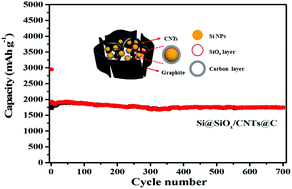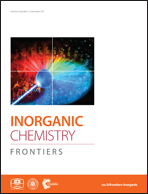A 3D pore-nest structured silicon–carbon composite as an anode material for high performance lithium-ion batteries†
Abstract
A novel silicon–carbon composite with a 3D pore-nest structure denoted as Si@SiOx/CNTs@C was prepared and studied. The results showed that agglomeration of nano-silicon particles is effectively inhibited by the addition of a surfactant; meanwhile, surfactant pyrolytic carbon (SPC) and a relatively dense SiOx mechanical binding layer on the surface of Si magnificently restrain the volume expansion during the lithiation process and are conducive to the formation of a stable SEI film. In addition, a 3D electron pathway was constituted by CNTs, graphite and SPC on the surface of Si to enhance the conductivity. The results showed that the capacity of the Si@SiOx/CNTs@C composite anode can be maintained at above 1740 mA h g−1 at a current density of 0.42 A g−1 after 700 cycles without capacity loss compared to the initial charge capacity, which indicated the excellent cycle performance of the composite material. Furthermore, a rule of thumb has been perceived by means of CV, cell charging/discharging measurements and their differential capacity analyses, which is characteristic of an electrode made of silicon as an active material. The finding contributes to the in-depth comprehension and general elucidation of the degradation mechanism of Si-based anode materials.



 Please wait while we load your content...
Please wait while we load your content...